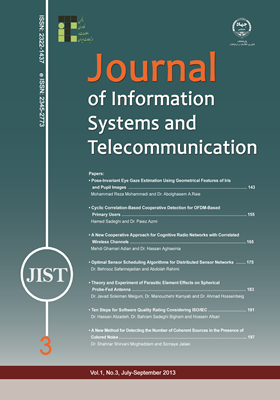Cyclic Correlation-Based Cooperative Detection for OFDM-Based Primary Users
محورهای موضوعی : Signal ProcessingHamed Sadeghi 1 , پائیز عزمی 2
1 - Tarbiat Modares
2 -
کلید واژه: Cooperative Spectrum Sensing, Cyclostationary, Cognitive Radio, Primary User Detection,
چکیده مقاله :
This paper develops a new robust cyclostationary detection technique for spectrum sensing of OFDM-based primary users (PUs). To do so, an asymptotically constant false alarm rate (CFAR) multi-cycle detector is proposed and its statistical behavior under null hypothesis is investigated. Furthermore, to achieve higher detection capability, a soft decision fusion rule for performing cooperative spectrum sensing (CSS) in secondary networks is established. The proposed CSS scheme aims to maximize the deflection criterion at the fusion center (FC), while the reporting channels are under Rayleigh fading. In order to be able to evaluate the performance of the cooperative detector, some analytic threshold approximation methods are provided for the cases where the FC has direct sensing capability or not. Through numerical simulations, the proposed local and CSS schemes are shown to significantly enhance CR network performance in terms of detection probability metric.
This paper develops a new robust cyclostationary detection technique for spectrum sensing of OFDM-based primary users (PUs). To do so, an asymptotically constant false alarm rate (CFAR) multi-cycle detector is proposed and its statistical behavior under null hypothesis is investigated. Furthermore, to achieve higher detection capability, a soft decision fusion rule for performing cooperative spectrum sensing (CSS) in secondary networks is established. The proposed CSS scheme aims to maximize the deflection criterion at the fusion center (FC), while the reporting channels are under Rayleigh fading. In order to be able to evaluate the performance of the cooperative detector, some analytic threshold approximation methods are provided for the cases where the FC has direct sensing capability or not. Through numerical simulations, the proposed local and CSS schemes are shown to significantly enhance CR network performance in terms of detection probability metric.


